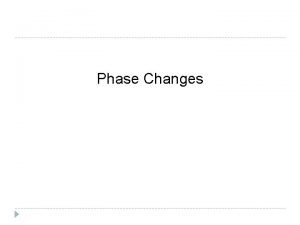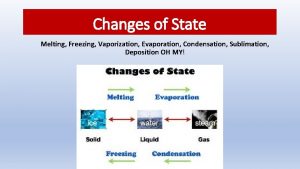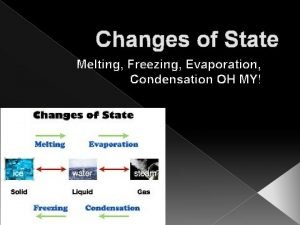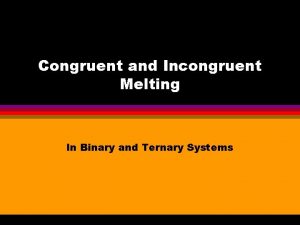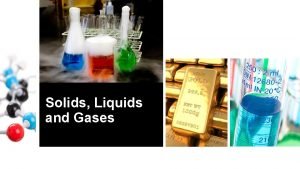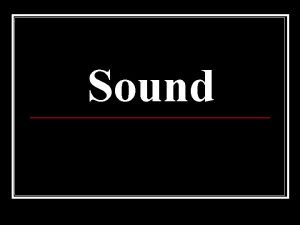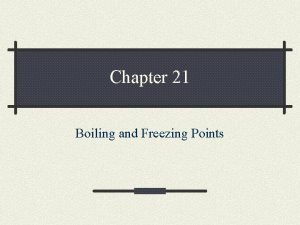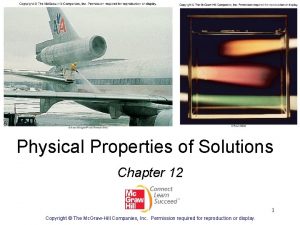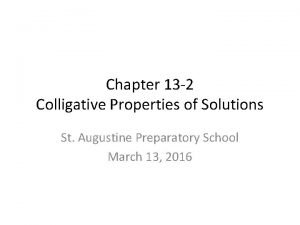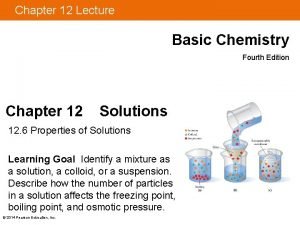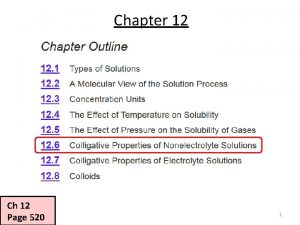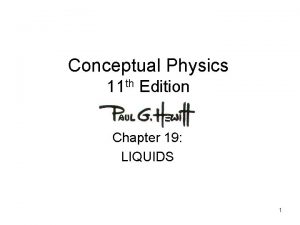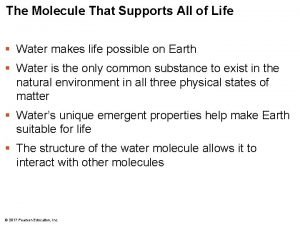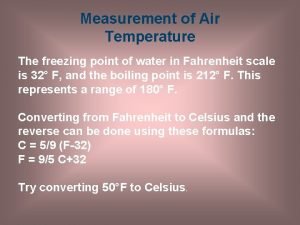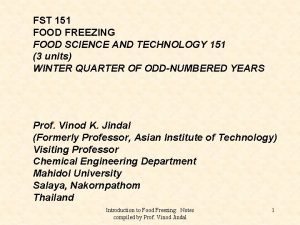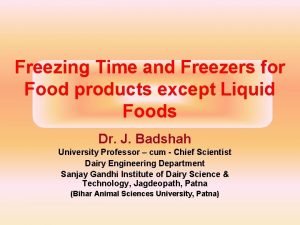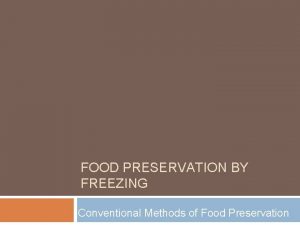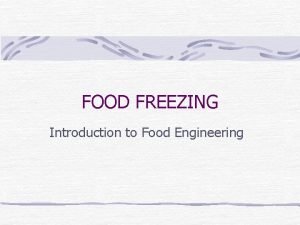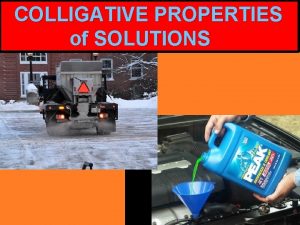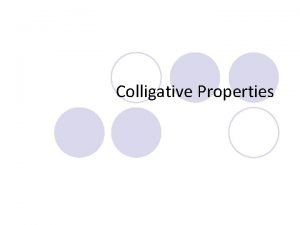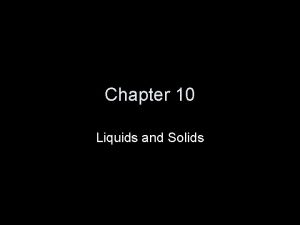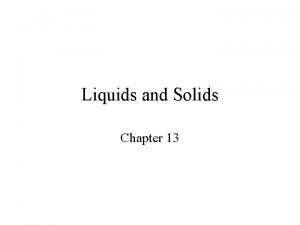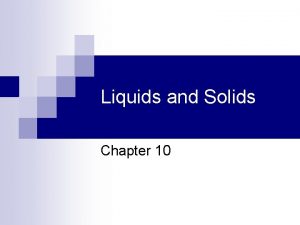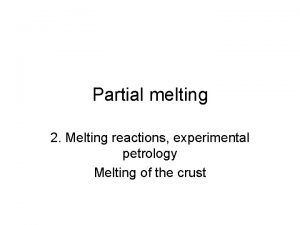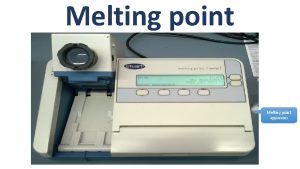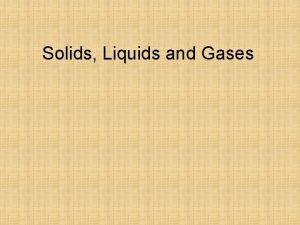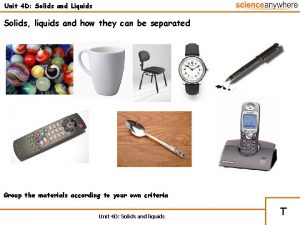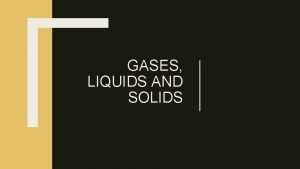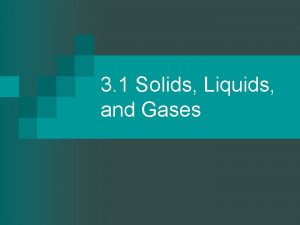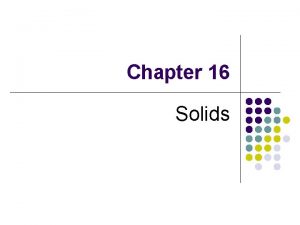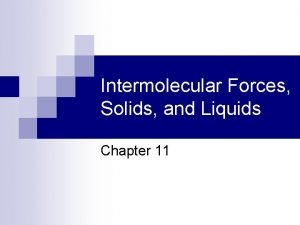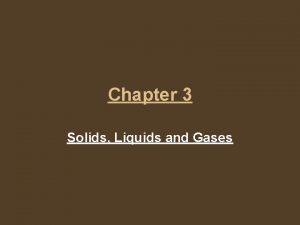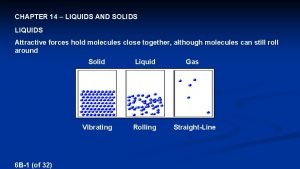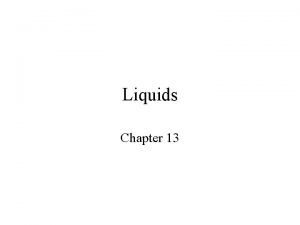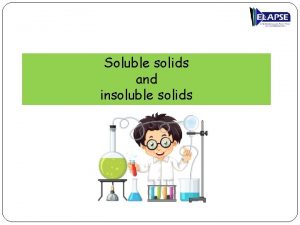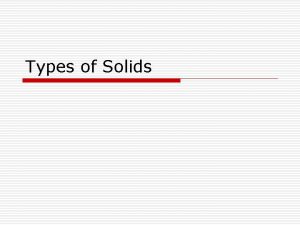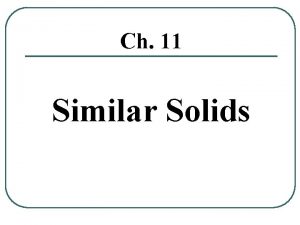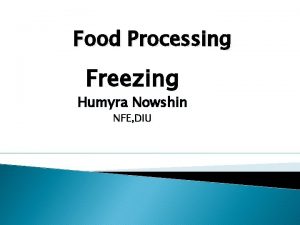CHAPTER 17 LIQUIDS Melting Freezing Most solids liquids













































- Slides: 45

CHAPTER 17 LIQUIDS

Melting & Freezing Most solids & liquids expand when heated l incr. kinetic energy • Particles forced farther apart – collide more & w/ greater force If temp. is incr. enough, particles will move far enough apart to slide over ea. other l ordered arrangement breaks down • MELTS

Melting & Freezing In liquids, @ a certain temp. particles travel so slowly they can’t slip past ea. other l FREEZES

Melting & Freezing All pure liquids have a definite freezing pt. All pure solids have a definite melting pt. For a pure subst. , the freezing pt. of the liquid is the same temp. as the melting pt. of the solid

Vapor Equilibrium Avg. kinetic energy of molecs. @ a given temp. is constant l not all moving same speed In liquids, surface molec. may gain enough K. E. to overcome attractive force & escape from surface of liquid. l l May also occur @ surface of solids These molecs. form a vapor

Vapor Equilibrium Gas - gaseous @ room temp. Vapor - gaseous state of substs. which are liquids or solids @ room temp. Vapor molec. may collide w/ surface of liquid. l If K. E. is low, may become part of liquid • little chance in open container • in closed container - greater chance

Vapor Equilibrium @ some pt. , there will be = # of molecs. leaving & returning to the suface l constant # of particles in liquid & vapor phase • - EQUILIBRIUM - no net change l l This is special type called DYNAMIC EQUILIBRIUM Rate of Evaporation = Rate of Condensation

Vapor Equilibrium When a subst. is in equilib. w/ its vapor, the gaseous phse is saturated w/ the vapor Physical change from liquid to vapor l l l X(l) X(g) Opposite process X(l) X(g)

Vapor Equilibrium 2 eqns. can be combined l X(l) X(g) • Reversible Change - Reach equilibrium when changes are occuring @ the same rate in both directions

Le. Chatelier’s Principle Vapor phase exerts a press. that’s dependent on temp. l The higher the temp. , the higher the vapor press. A liquid & its vapor will reach equilib. @ a specific press. for any temp.

Le. Chatelier’s Principle - A stress applied to a system @ equilibrium causes a readjustment to offset the stress (reduce stress) l This stress may be a chg. in temp. , press. , concentration, etc.

Le. Chatelier’s Principle Freezing & melting of H 2 O is a reversible syst. which can come to equilibrium H 2 O(l) H 2 O(s) When press. is applied to something, it gets smaller l If press. is applied to ice, it causes a stress - to relieve the stress, the ice will melt • liquid water takes up less space than ice

Measuring Vapor Pressure Vapor press. is a function of temp. l as temp. incr. , vapor press. incr. Substs. w/ low vapor press. have strong intermolec. forces Substs. w/ high vapor press. have weak intermolec. forces.

Melting Point In a mixture of solid & liquid, there is a dynamic equilib. l Solid Liquid • Ea. state is also in equilib. w/ its vapor • Only 1 vapor, so solid & liquid have the same vapor press.

Melting Point - The temp. @ which the vapor press. of the solid & vapor press. of the liquid are = l Melting pt. = Freezing pt.

Melting Point Melting Pt. depends on intermolec. forces in the subst. l l Substs. w/ weak intermolec. forces have lower melting pts. than substs. w/ strong forces Nonpolar substs. w/ low molar masses have lower melting pts. than polar substs. w/ low molar masses

Sublimation - The process of changing directly from a solid to a gas or vapor w/out passing thru the liquid state l l l Solid Vapor Solids have vapor press. large enough @ room temp. to vaporize readily Ex. dry ice & moth balls

Boiling Point Liquid & vapor can be in equilib. only in a closed container. l l in open container, molecs, escape into the air Evaporation - escape of molecs. from the surface of a liquid

Boiling Point At temp. incr. , K. E. incr, & vapor press. incr. l l K. E. eventually becomes large enough to overcome internal press. due to air pushing on the surface. Molecs. move fast enough, they are pushed far apart & form gas bubbles which rise to the surface.

Boiling Point Normal Boiling Point - The temp. @ which the vapor press. = std. atmospheric press. Boiling is a function of pressure l @ lower press. , boiling pt. is lower Evaporation occurs only @ the surface; boiling occurs throughout the liquid l Boiling pt. = Condensation pt.

Boiling Point Adding energy to a liquid @ its B. P. will chg it to a gas Removing energy from a gas @ its B. P will chg it to a liquid

Boiling Point Diff. liquids boil @ diff. temps. Volatile liquid - boils @ low temp. & evaporates readily l has high vapor press @ room temp. • Ex. - alcohol, acetone Nonvolatile Liquid - boils @ high temp & evaporates slowly @ room temp. l low vapor press. • Ex - oil, molasses, glycerin

Liquefaction of Gases - The condensation of substs. which are normally gases To liquefy: 1. Cool - slow dn. molecs so van der Waals forces can bind molecs. together 2. Compress - get molecs close enough for van der Waals forces to take effect

Liquefaction of Gases Tc - Critical Temperature - Temp. above which no amt. of press. will cause the gas to liquefy. Pc - Critical Pressure - Minimal press. that will cause a gas to liquefy @ its critical temp.

Liquefaction of Gases Tc indicates relative strength of attractive forces betw. particles l l Low Tc - weak forces High Tc - strong forces

Phase Diagrams - graphically represents changes of state @ varying temps. & press.

Phase Diagram for Water Line AB - solid-vapor line l represents vapor press. of ice from -100 o. C to pt. B Line BD - Liquid-vapor line l l l Vapor press. curve for liquid water Gives temp. & press. @ which liquid water & water vapor are in equilib. represents vapor press. of liquid water from pt. B to 374 o. C (Tc for water)

Phase Diagram for Water Pt. B - Triple Point - all 3 states are in equilibrium Pt. D - Critical Point - above this there is no vapor curve l Only gaseous state exists @ press. & temps. above this point

Phase Diagram for Water Tm - melting point - occurs where line BC is cut by std. atmos. press. l l l Vapor Press. of liquid & solid = atmos. press @ this pt. Line BC indicates press. -temp. conditions under which solid & liquid can be in equilib. Only line AD represents vapor press. info.

Phase Diagram for Water Tb - Boiling Pt. - Temp. @ which liquidvapor equilib. curve is cut by std. atmos. press. line

Phase Diagram for Water Line BC has (-) Slope - indicates that a rise in press. will lower the freezing pt. l - Water expands when it freezes Most substs. contract when they freeze l this line would have a (+) slope

Energy & Change of State When heat is added to a solid, its temp. incr. until its melting pt. is reached l l If more heat is applied, the subst. begins to melt Before melting pt. is reached added energy incr. K. E. of molecs. - Temp. is raised During a change of state, temp. remains constant l All energy goes to changing the position of particles & incr. potential energy

Energy & Change of State Enthalpy of Fusion (DHfus) - Energy required to melt 1 g of a subst. @ its melting point Enthalpy of Vaporization (DHvap) - Energy required to vaporize 1 g of a subst. @ its boiling point Specific Heat Capacity (Cp) - Energy required to raise the temp. of 1 g of a subst. by 1 Co

Energy & Change of State Ex. Calculate the energy needed to convert 10. 0 g of ice @ -10. 0 o. C to steam @ 150. 0 o. C 1. Warm ice to 0 o. C. � 2. Melt ice � 3. Warm water from 0 o. C to 100. 0 o. C � 4. Vaporize (boil) water � 5. Warm steam from 100. 0 o. C to 150. 0 o. C

Hydrogen Bonding In many substs. , the predicted m. p. ’s & b. p’s differ from actual ones These substs. have 2 things in common: 1. Contain H

Hydrogen Bonding 2. H is covalently bonded to a highly electroneg. atom l Electroneg. atom has almost complete possession of shared e- pr. • Molec. is highly polar • H has very strong partial (+) charge • almost like a bare p+

Hydrogen Bonding Only elems. electroneg. enough to cause this are N, O, &F H is always covalently bonded - H+ doesn’t exist l partial (+) charge on H end of molec. is much stronger than other dipoles • H is the only elem. that has this prop. • All others have inner e- levels

Hydrogen Bonding The attraction betw. the H end of one molec. & the (-) end of other molecs. is very strong. l l not nearly as strong as a chemical bond This attractive force in these substs. is called a Hydrogen Bond • H atom tends to hold the 2 molecs. firmly together • Considered apart from other dipole attractions bec. of its greater effect on the props. of substs.

Hydrogen Bonding in Water Effects of H-bonding can be seen in water l When frozen, a molec. of water is H-bonded to 4 other water molecs. • H atoms are attracted to the O atoms of neighboring molecs • Open crystalline structure

Hydrogen Bonding in Water When ice melts, many H bonds are broken not all l l The lattice collapses - molecs. move closer together water is more dense than ice

Hydrogen Bonding in Water As water is heated above 0 o. C, more H bonds are broken l @ 3. 98 o. C, most H bonds are broken • most dense l As water is heated more, water expands

Surface Tension & Capillary Rise Surface Tension - The apparent elasticity of a surface that’s due to unbalanced forces on surface particles l Particles in the middle of the liquid are subjected to attractive forces in all directions

Surface Tension & Capillary Rise Surface particles can’t be pulled in all directions l l creates a “skin” on the surface particles on surface have a net force inward this is why liquids form spheres when dropped surface molecs. are pulled inward by the rest of the molecs. in the drop

Surface Tension & Capillary Rise Unbalanced forces also account for Capillary Rise l The rise of a liquid in a tube of small diameter If there’s an attractive force betw. a liquid & the walls of the capillary tube, liquid will rise in tube l l attractive force relieves unbalanced forces Liquid will rise until forces are balanced

Surface Tension & Capillary Rise Mercury has a very strong surface tension, but won’t rise in a capillary tube l l does not “wet” the glass attractive force betw. Hg & glass (adhesive force) is not strong enough to overcome the attractive force betw. the Hg atoms (cohesive force)
 Phase changes
Phase changes Melting evaporation condensation freezing
Melting evaporation condensation freezing Melting evaporation condensation freezing
Melting evaporation condensation freezing Chapter 14 solids liquids and gases worksheet answers
Chapter 14 solids liquids and gases worksheet answers Kinetic molecular theory of solids
Kinetic molecular theory of solids Chapter 11 - states of matter: liquids and solids
Chapter 11 - states of matter: liquids and solids Congruent compound
Congruent compound Expansion of solids liquids and gases examples
Expansion of solids liquids and gases examples Buoyancyability
Buoyancyability Site:slidetodoc.com
Site:slidetodoc.com State of matter venn diagram
State of matter venn diagram Properties of solid
Properties of solid Why are gases easy to compress?
Why are gases easy to compress? Process of liquid to gas
Process of liquid to gas Adhesive force
Adhesive force Specific cake resistance formula
Specific cake resistance formula Liquids and solids menu
Liquids and solids menu Lesson outline lesson 1 solids liquids and gases answer key
Lesson outline lesson 1 solids liquids and gases answer key Kesler science.com
Kesler science.com Red liquid element
Red liquid element How does sound travel through solids liquids and gases
How does sound travel through solids liquids and gases Liquid information
Liquid information Motion of particles in solids, liquids and gases
Motion of particles in solids, liquids and gases Freezing point chapter 21
Freezing point chapter 21 Freezing point chapter 12
Freezing point chapter 12 Freezing point chapter 13
Freezing point chapter 13 Freezing point chapter 13
Freezing point chapter 13 Freezing point chapter 12
Freezing point chapter 12 Tf=kfm
Tf=kfm Freezing point chapter 8
Freezing point chapter 8 Chapter 19 liquids exercises answers
Chapter 19 liquids exercises answers Cool chilly cold freezing
Cool chilly cold freezing Egg donor nashville
Egg donor nashville Expansion upon freezing
Expansion upon freezing Expansion upon freezing
Expansion upon freezing Transmission timeout freezing in mobile computing
Transmission timeout freezing in mobile computing What is the market form of imported meat
What is the market form of imported meat Air freezing point
Air freezing point Freezing of fish
Freezing of fish Fluidized bed freezer
Fluidized bed freezer What is blast freezer
What is blast freezer Methods of freezing food
Methods of freezing food Introduction to food engineering
Introduction to food engineering What is vapor pressure lowering
What is vapor pressure lowering Why freezing point decreases on adding solute
Why freezing point decreases on adding solute Pure solvent
Pure solvent
